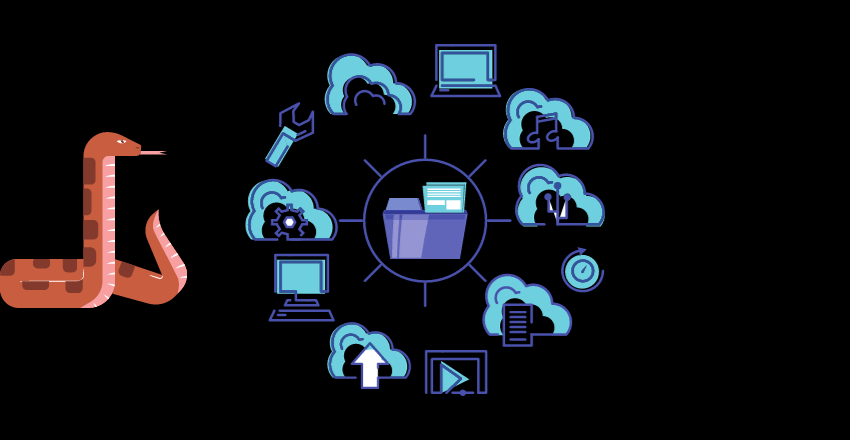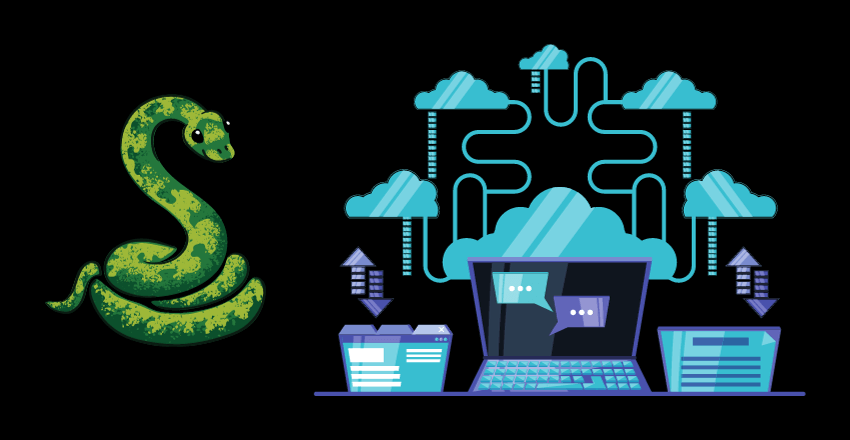 Python has become a popular choice for building solutions in the cloud. Its simplicity, readability, and extensive library support make it an excellent language for developing efficient and scalable cloud solutions.
Python has become a popular choice for building solutions in the cloud. Its simplicity, readability, and extensive library support make it an excellent language for developing efficient and scalable cloud solutions.
Python’s strong community also offers support and resources for developers building solutions with Python in the cloud. Leveraging Python for efficient cloud solutions has become the norm, and many organizations have successfully implemented expert Python cloud solutions to maximize their business outcomes.
Why Choose Python for Cloud Solutions?
Python has become a popular language for building efficient and scalable cloud solutions. With its simple and easy-to-read syntax, Python is an ideal language for developing applications that can quickly adapt to changing business needs.
Leveraging Python for efficient cloud solutions has become increasingly popular in recent years due to its extensive library support and strong community. Python provides developers with a wide range of libraries and frameworks that make it easier to build complex applications quickly. These libraries and frameworks are continuously being updated and improved, ensuring that developers can always take advantage of the latest technologies.
Moreover, Python’s simplicity and readability make it an ideal choice for cloud solutions. Its syntax is easy to learn and understand, making it more accessible to a wider audience. Python’s focus on readability also makes it easier for developers to collaborate and work together on a project.
When it comes to cloud solutions, flexibility is key. Python is a versatile language that can be used for a wide range of applications. It is common to use Python in cloud solutions because it is compatible with most cloud infrastructure and services. Python’s compatibility also makes it easy to integrate with other cloud technologies, such as Docker and Kubernetes.
For example, in Flask, a popular Python web framework, creating a simple web application is as easy as:
from flask import Flask app = Flask(__name__) @app.route('/hello') def hello_world(): return 'Hello, World!'
Similarly, Django, another popular Python web framework, allows developers to build complex web applications quickly and easily. For example, creating a new Django project is as simple as running:
django-admin startproject myproject
The strong community around Python has also made it easier for developers to find help and support when building cloud solutions. With countless online forums, tutorials, and documentation available, developers can quickly find solutions to common problems, making it easier to build and deploy Python cloud solutions.
Leveraging Python for efficient cloud solutions offers many advantages. Its simplicity, readability, extensive library support, and strong community make it an ideal language for building cloud solutions that are scalable, adaptable, and easy to maintain. By incorporating Python into their cloud solutions, businesses can take advantage of the latest technologies and stay ahead of the competition.
Best Python Frameworks for Cloud Solutions
Python offers a range of powerful frameworks for building cloud solutions. Here, we compare and contrast two popular frameworks: Django and Flask.
| Framework | Features | Use Cases |
|---|---|---|
| Django | Full Stack framework with built-in support for admin interface, ORM, and templating engine. Includes a range of batteries | Well-suited for complex web applications with built-in user authentication, routing, and database handling |
| Flask | Micro framework with minimal dependencies | Ideal for small to medium web applications that require customizability and flexibility |
Both frameworks have their unique strengths, and the choice between them should be based on the specific needs and constraints of the project. Here’s a code example to demonstrate the difference in their approaches:
Django:
from django.db import models class Book(models.Model): title = models.CharField(max_length=255) author = models.CharField(max_length=255) published_date = models.DateField() def get_books(request): books = Book.objects.all() return render(request, 'books.html', {'books': books})Flask:
from flask import Flask, jsonify app = Flask(__name__) @app.route('/books') def get_books(): books = [ {'title': 'The Alchemist', 'author': 'Paulo Coelho', 'published_date': '1988'}, {'title': '1984', 'author': 'George Orwell', 'published_date': '1949'}, ] return jsonify({'books': books})
As seen in the code examples, Django’s ORM provides a more intuitive and streamlined way of handling databases when compared to Flask’s approach. However, Flask’s micro framework allows for greater customization and flexibility when setting up APIs.
Other popular Python frameworks for cloud solutions include Pyramid, Tornado, and Bottle. The choice of framework should be based on the project requirements and the level of expertise of the development team.
Scaling Python Cloud Solutions
Building solutions with Python in the cloud provides a range of benefits, including scalability and efficient resource utilization. However, as traffic and workload increase, it’s important to scale up Python cloud solutions to ensure optimal performance. Here, we discuss some strategies for scaling Python cloud solutions that leverage Python’s inherent flexibility and scalability.
Horizontal Scaling
Horizontal scaling involves adding more compute resources or nodes to the existing infrastructure to handle increased traffic and workload. Python cloud solutions make horizontal scaling easier since they are designed to run distributed workloads.
One way to achieve horizontal scaling is to use load balancers like AWS Elastic Load Balancer or Azure Load Balancer, which can distribute incoming traffic across multiple compute nodes. These load balancers can automatically route traffic to the least overloaded node, thereby ensuring optimal resource utilization and application performance.
Cloud Services for Scaling
Cloud services like AWS Elastic Beanstalk and Google App Engine allow developers to deploy, manage, and scale Python cloud solutions with ease. With Elastic Beanstalk, developers can deploy Python applications to automatically scaling clusters of Amazon EC2 instances. Similarly, Google App Engine allows developers to deploy Python applications on a fully managed serverless platform that scales automatically.
Code Example: Scaling with AWS Elastic Beanstalk
The following Python code shows how to use AWS Elastic Beanstalk to deploy and scale a Flask application:
from flask import Flask app = Flask(__name__) @app.route('/') def hello(): return 'Hello, World!' if __name__ == '__main__': app.run (debug=True)
Once you have written the code, you can deploy it to Elastic Beanstalk with the following command:
eb create my-application
This command will create a new Elastic Beanstalk environment, where your application will be hosted on auto-scaling EC2 instances. You can monitor and manage the environment using the Elastic Beanstalk console.
Scaling Python cloud solutions is essential for ensuring optimal performance and resource utilization. Horizontal scaling and cloud services like AWS Elastic Beanstalk are effective strategies for scaling Python cloud solutions. With these strategies in place, Python cloud solutions can handle increased traffic and workload with ease, enabling businesses to maximize their efficiency and scalability.
Python Cloud Solutions in Industry

Python has gained immense popularity in recent years as a go-to language for building cloud solutions due to its simplicity, readability, and extensive library support. Many industries have adopted Python cloud solutions to maximize their efficiency and scalability, making it an indispensable tool for developers.
One example of an industry that has benefitted from expert Python cloud solutions is the financial services sector. Companies like JP Morgan and Goldman Sachs have leveraged Python for their cloud solutions due to its ease of use and flexibility. Python has enabled them to build scalable and reliable solutions that can handle large volumes of financial data.
Another industry that has seen tremendous growth in Python cloud adoption is healthcare. Python frameworks like Django and Flask have been utilized to build healthcare solutions that manage patient data, medical records, and telemedicine platforms. Python has enabled healthcare providers to build secure and reliable cloud solutions that deliver high-quality care to patients.
| Industry | Benefits of Python Cloud Solutions |
|---|---|
| Finance | Scalability, Reliability, Handling large volumes of financial data |
| Healthcare | Security, Reliability, Management of patient data, Telemedicine platforms |
Python’s scalability and ease of use have also made it a popular choice for e-commerce platforms. Companies like Amazon and eBay have seen significant improvements in their cloud solutions by adopting Python. Python frameworks like Django and Flask have enabled e-commerce companies to build scalable and secure solutions that handle high volumes of traffic.
Python’s popularity in cloud solutions is not limited to these industries. Other industries like gaming, education, and transportation have all seen the potential of Python in the cloud. As organizations continue to seek efficient and scalable solutions, the use of Python in cloud development is expected to grow exponentially.
As Python continues to evolve and offer new capabilities, its potential in cloud solutions will only continue to grow. Python cloud solutions offer developers and organizations the ability to build efficient, reliable, and scalable solutions, making it a valuable tool for any cloud development project.
Security Considerations for Python Cloud Solutions

Security is a crucial aspect when it comes to developing cloud solutions. With Python cloud solutions, you need to take extra measures to protect your application from cyber-attacks, data breaches, and other security threats.
One of the most common security vulnerabilities in Python cloud solutions is the injection of malicious code into the application. This can happen if developers use untrusted inputs without proper validation. To prevent this, you need to enforce strict validation rules and sanitize any user inputs before processing them.
Another potential security threat is the use of weak encryption algorithms or implementation of encryption in an incorrect way. To avoid this, it is recommended to use strong encryption algorithms and follow best practices for encryption.
Additionally, it is important to ensure that your Python code is free from vulnerabilities like buffer overflows or integer overflows. You can use tools like PyLint, Flake8, Bandit to identify and fix these types of vulnerabilities.
Secure Coding Practices for Python Cloud Solutions
Here are some secure coding practices that you can incorporate when building Python cloud solutions:
- Enforce strong passwords: Require users to create strong passwords and implement password complexity rules.
- Implement Two-Factor Authentication: Use two-factor authentication to add an extra layer of security to your application.
- Use Secure Libraries: Use secure libraries to handle sensitive data such as passwords, user credentials, and other sensitive information.
- Implement Input Validation: Validate and sanitize all user inputs to prevent injection attacks.
- Encrypt Data: Use encryption to protect sensitive data in transit and at rest.
- Use Role-based Access Control: Implement role-based access control to restrict access to sensitive data and functionality.
- Continuous Monitoring: Continuously monitor your application for vulnerabilities and patch them to ensure your application is up to date and secure.
By following these secure coding practices, you can ensure the security of your Python cloud solutions and protect against potential security vulnerabilities.
Deploying Python Cloud Solutions
Deploying Python cloud solutions can seem intimidating, but with the right tools and guidance, it can be a straightforward process. In this section, we will cover the steps involved in deploying Python cloud solutions using popular platforms like AWS, Azure, or Google Cloud, and provide tips for smooth deployments.
Choosing a Cloud Platform
Before deploying your Python cloud solution, it is important to choose the right cloud platform that meets your requirements. AWS, Azure and Google Cloud are among the most popular cloud platforms widely used for deploying Python solutions. AWS Elastic Beanstalk and Google App Engine are popular PaaS (Platform-as-a-Service) options that provide a simple and fast way to deploy and manage web applications. Azure also offers PaaS solutions like Azure App Service, which provides a managed platform for building, deploying, and scaling web apps.
Creating a Deployment Package
Once you have chosen your preferred cloud platform, you will need to create a deployment package for your Python application. This usually involves packaging your application code along with any necessary dependencies and configuration files into a zip file. Each platform has its own way of creating a deployment package, so it’s important to refer to their documentation for detailed guidance.
Deploying the Application
After creating the deployment package, the next step is to deploy the application. The process for deploying a Python application may vary depending on the platform you choose. For example, with AWS Elastic Beanstalk, you can deploy your application by uploading the deployment package through the AWS Management Console or using a command-line interface (CLI) tool like the AWS CLI. For Google App Engine, you can deploy your application using the gcloud command-line tool or the Google Cloud Console.
Scaling and Maintenance
Deploying your Python application is just the beginning. To maximize efficiency and handle increasing traffic, it’s important to scale and maintain your application. Most cloud platforms offer features like auto-scaling and load balancing to help scale applications seamlessly. AWS Elastic Beanstalk, for example, provides automatic scaling options that can automatically scale your application based on traffic. Azure App Service also offers autoscaling features that can scale your application automatically based on demand. To ensure smooth operation of your application, it’s important to monitor and optimize it for performance and cost-efficiency.
Deploying a Python application in the cloud can seem like a daunting task, but with the right guidance, it can be a smooth process. By leveraging Python for efficient cloud solutions and choosing the right platform and tools, you can easily deploy and scale your applications to meet your business needs.
Monitoring and Optimizing Python Cloud Solutions
Monitoring and optimizing Python cloud solutions is crucial for ensuring their efficiency and cost-effectiveness. By implementing proper monitoring tools and performance optimization strategies, businesses can maximize the benefits of leveraging Python for efficient cloud solutions.
Monitoring Tools and Techniques:
There are various tools and techniques available for monitoring Python cloud solutions. One widely used tool is AWS CloudWatch, which provides real-time monitoring of applications and resources running on AWS. With CloudWatch, businesses can track metrics, collect and monitor log files, set alarms, and automatically react to changes in resources or application performance.
Another popular tool is Datadog, which offers comprehensive monitoring of cloud infrastructure, applications, and logs. Datadog provides real-time visibility into system behavior, enabling businesses to detect and resolve issues before they impact the end-user experience. Additionally, Datadog offers customizable analytics and alerts, allowing businesses to monitor and optimize their cloud resources effectively.
Performance Optimization Strategies:
There are several performance optimization strategies that businesses can implement to maximize the efficiency of Python cloud solutions. One common approach is to use caching to reduce the number of database queries and API calls. By caching frequently accessed data, businesses can improve application speed and reduce the workload on the server.
Another effective strategy is to use asynchronous programming to handle I/O-bound tasks. Asynchronous programming allows multiple tasks to run concurrently, improving the performance of applications that rely heavily on I/O operations.
Lastly, businesses can leverage containerization technologies like Docker to optimize cloud resources usage. With Docker, businesses can package applications and their dependencies into lightweight containers, allowing them to run consistently across different environments and minimize resource usage.
Cost Optimization Approaches:
While Python cloud solutions offer many benefits, they can also be costly if not optimized properly. To reduce the cost of running Python cloud solutions, businesses can use several approaches:
- Use auto-scaling to automatically adjust the number of resources based on demand.
- Use reserved instances to reduce the cost of running instances for an extended period.
- Use spot instances to take advantage of unused compute capacity in the cloud at a lower cost.
- Use serverless computing to pay only for the actual usage of the application.
By implementing these cost optimization approaches, businesses can reduce their cloud costs significantly.
By effectively monitoring and optimizing Python cloud solutions, businesses can experience increased efficiency, reduced costs, and improved end-user experiences.
With a wide range of tools and techniques available, businesses can take advantage of Python’s scalability and flexibility to create highly efficient and effective cloud solutions.
Challenges and Solutions in Python Cloud Development

Developing Python cloud solutions can present various challenges that require careful consideration. In this section, we will discuss some common challenges and offer solutions to overcome them, ensuring that your Python cloud solutions are efficient, scalable, and secure.
Debugging in the Cloud
Debugging in a cloud environment can be challenging, as traditional debugging methods may not be effective due to the distributed nature of cloud-based applications. To overcome this challenge, developers can leverage tools such as AWS X-Ray, which provides a visual representation of services and their interactions to help identify issues. Another approach is to implement logging and tracing capabilities throughout the application code, which can help pinpoint errors and provide context to aid in debugging.
Managing Dependencies
Managing dependencies and ensuring their compatibility with different versions can be a challenge, particularly when working with multiple frameworks and libraries. One way to mitigate this risk is to use containerization technologies such as Docker to package the application and its dependencies into a portable and consistent format. This approach can help reduce compatibility issues and make applications more easily transferable between different environments.
Handling Data Consistency
Ensuring data consistency across multiple services and instances can be a challenge, particularly in distributed cloud environments. One way to address this challenge is to implement patterns such as Saga or CQRS, which can help maintain data consistency by ensuring that all operations are either fully completed or rolled back. Additionally, using distributed database systems such as Amazon Aurora or Google Cloud Spanner can help ensure data consistency and reliability.
Integrating with Other Cloud Services
Integrating Python cloud solutions with other cloud services can present integration challenges, particularly when working with services that require different protocols and data formats. To address this challenge, developers can leverage integration platforms such as Apache Camel or AWS Lambda to help simplify and streamline integration processes. These technologies can help facilitate communication between different services and ensure compatibility between different protocols and formats.
By addressing these common challenges, developers can ensure that their Python cloud solutions are efficient, scalable, and secure, enabling them to deliver better outcomes and creating opportunities for innovation. With the right tools, frameworks, and strategies, Python can be a powerful tool for building solutions in the cloud.
Python cloud solutions offer a powerful and efficient way to build scalable and reliable applications in the cloud. By leveraging Python’s strengths, such as its simplicity, readability, and extensive library support, developers can create robust cloud solutions quickly and efficiently.
Get Expert Python Cloud Solutions
Whether you’re just starting with Python cloud solutions or already an expert, building solutions with Python in the cloud can be challenging. But with the right tools and expertise, you can overcome any challenge and create efficient solutions that meet your business needs.
At XYZ Company, we offer expert Python cloud solutions that can help you take your business to the next level. From choosing the right framework to scaling and optimizing your cloud solutions, our team of experienced developers can help you achieve your goals.
FAQ

Q: What are Python cloud solutions?
A: Python cloud solutions refer to the use of the Python programming language for building efficient and scalable solutions in the cloud. This involves leveraging Python’s vast libraries, simplicity, and strong community support to develop applications and services that can be easily deployed and managed in cloud environments.
Q: Why should I choose Python for cloud solutions?
A: Python is an excellent choice for cloud solutions due to its simplicity, readability, extensive library support, and strong community. It provides a flexible and easy-to-use approach for developing cloud applications. With Python, you can quickly prototype and develop scalable solutions, making it a preferred language for building efficient and effective cloud solutions.
Q: What are the best Python frameworks for cloud solutions?
A: Some popular Python frameworks for cloud solutions include Django and Flask. Django is a full-featured framework that offers a lot of out-of-the-box functionality, making it suitable for large-scale applications. On the other hand, Flask is a lightweight framework that provides flexibility and simplicity, making it a great choice for smaller projects or building microservices. Both frameworks have their strengths and use cases, so it’s important to consider your specific requirements when choosing one for your cloud solutions.
Q: How can I scale Python cloud solutions?
A: Scaling Python cloud solutions can be achieved through strategies like horizontal scaling, load balancing, and utilizing cloud services like AWS Elastic Beanstalk or Google App Engine. Horizontal scaling involves adding more instances of your application to handle increased traffic and workload. Load balancing distributes traffic evenly across multiple instances to ensure optimal performance. Cloud services like AWS Elastic Beanstalk or Google App Engine provide managed environments for deploying and scaling your Python applications. By utilizing these strategies and services, you can easily scale your Python cloud solutions as needed.
Lydia is a seasoned technical author, well-versed in the intricacies of software development and a dedicated practitioner of Python. With a career spanning 16 years, Lydia has made significant contributions as a programmer and scrum master at renowned companies such as Thompsons, Deloit, and The GAP, where they have been instrumental in delivering successful projects.
A proud alumnus of Duke University, Lydia pursued a degree in Computer Science, solidifying their academic foundation. At Duke, they gained a comprehensive understanding of computer systems, algorithms, and programming languages, which paved the way for their career in the ever-evolving field of software development.
As a technical author, Lydia remains committed to fostering knowledge sharing and promoting the growth of the computer science community. Their dedication to Python development, coupled with their expertise as a programmer and scrum master, positions them as a trusted source of guidance and insight. Through their publications and engagements, Lydia continues to inspire and empower fellow technologists, leaving an indelible mark on the world of scientific computer science.







